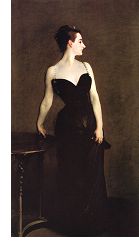
Feature Archive |
Notorious Portraits
| By John Malyon |
Warning: This article is not intended for younger audiences. There's nothing I would characterize as pornographic, and nothing that can't be found at mainstream museum and fine art websites. However, some of the discussion and images deal with mature subject matter.
| Scandale: The Salons | |
| Revenge: Artimesia Gentileschi | |
| Sittings from Hell: Sargent/Carnation, Lily, Lily, Rose | |
| Private Commissions: Khalil Bey | |
| Rejected Portraits: Kahlo/The Suicide of Dorothy Hale | |
| Villains: Fra Bartolommeo/Savonarola | |
| Surprises: Rembrandt |
From the first Realist and Impressionist works exhibited at the Paris Salons, through the Armory Show which introduced America to Picasso, Duchamp and Matisse, right up to the latest works by Damien Hirst and Andres Serrano, the story of modern art has been the story of a temporarily scandalized and outraged public.
This has become so deeply ingrained in the artistic tradition that many artists and collectors now seem to use a work's ability to provoke shock and disgust as a barometer of its artistic merit. Hence the double meaning in the name of last year's Sensation show at the Brooklyn Museum of Art: in addition to creating a public frenzy, it was designed to provoke a personal emotional reaction - something which is becoming harder and harder to accomplish.
In the 19th century, a well-established convention of fine art was that people in antiquity did not wear much in the way of clothes. Therefore it was quite usual for historical, mythological and even Biblical paintings to show men and women naked and in fairly racy situations. Édouard Manet created two of the most famous and most audacious paintings of the Paris Salons by updating classic paintings into a contemporary setting: Le Déjeuner sur l'Herbe (1863, exhibited at the 1863 Salon des Refusés) and Olympia (1863, exhibited at the Salon of 1865).
 Le Déjeuner sur l'Herbe is very loosely based on Concert Champêtre, by Giorgione and/or Titian, and shows a couple of Parisian men picnicking in the countryside with a naked woman who can only be thought to be a prostitute. Olympia shows the same model, Victorine Meurent, in a pose reminiscent of Titian's famous Venus of Urbino. But in this painting "Venus" is not a lofty ideal image but a personalized individual; not a distant Goddess of an extinct religion but a rather short, plain and hard-edged prostitute ready for her next customer.
Le Déjeuner sur l'Herbe is very loosely based on Concert Champêtre, by Giorgione and/or Titian, and shows a couple of Parisian men picnicking in the countryside with a naked woman who can only be thought to be a prostitute. Olympia shows the same model, Victorine Meurent, in a pose reminiscent of Titian's famous Venus of Urbino. But in this painting "Venus" is not a lofty ideal image but a personalized individual; not a distant Goddess of an extinct religion but a rather short, plain and hard-edged prostitute ready for her next customer.Manet provoked these public scandals quite intentionally. His motivation was of course partly self-serving, but he was working firmly in the Realist tradition by helping to break through the artifice of Academic art that was strangling painting in France. (In fact the rowboat in the background of Le Déjeuner sur l'Herbe is a nod to a scandalous painting from several years earlier, Young Ladies on the Banks of the Seine, by the master Realist Gustave Courbet.)
 John Singer Sargent was another artist trying to make a splash in the Paris Salons, and he did so far beyond his greatest expectations or worst fears. The resulting furor drove him from France but helped make him a superstar in Great Britain.
John Singer Sargent was another artist trying to make a splash in the Paris Salons, and he did so far beyond his greatest expectations or worst fears. The resulting furor drove him from France but helped make him a superstar in Great Britain.Portrait of Madame **** (1884, now known as Madame X) is magnificently bold and haughty portrait of 23-year-old Virginie Gautreau - an American whose behavior was already something of a scandal in Parisian society. Madame Gautreau was widely known to have had an affair with Dr. Samuel Pozzi, whom Sargent had coincidentally also captured in a magnificently bold and sensual portrait.
Especially shocking in the Madame X portrait was the seemingly minor detail that the right strap of her gown had slipped off her shoulder. (The strap was later repainted, so there is no further danger of the painting's dress falling off. Click here to see a reproduction of the painting as originally exhibited.)
Marcel Duchamp's masterpiece, Nude Descending a Staircase, which was exhibited in 1913 at the famous Armory Show in New York, was shocking on many levels. The American public was taken aback at the nonrealistic approach (it was described as looking like "an explosion in a shingle factory") and simultaneously appalled at the open display of a nude (even though the sex of the figure can't be figured out).
What's even more interesting is that Duchamp's Cubist colleagues, so busy turning the human sensorium inside-out, proved to be as easily scandalized as any Midwestern schoolmarm, rejecting the painting on ideological grounds and causing Duchamp to remove it from the 1912 Salon des Indépendants. No cubist would dare paint something so bourgeois and unfashionable as a nude (At least change the title, implored Gleizes); equally problematic was the painting's representation of action, while Cubist principles could supposedly only be applied to static subjects.
Additional Resources:
Click here to read more about Madame X
| Continue to next page: Revenge |
This article is copyright 2000 by John Malyon. Please do not republish any portion of this article without written permission.
John Malyon can be contacted at jmalyon@artcyclopedia.com